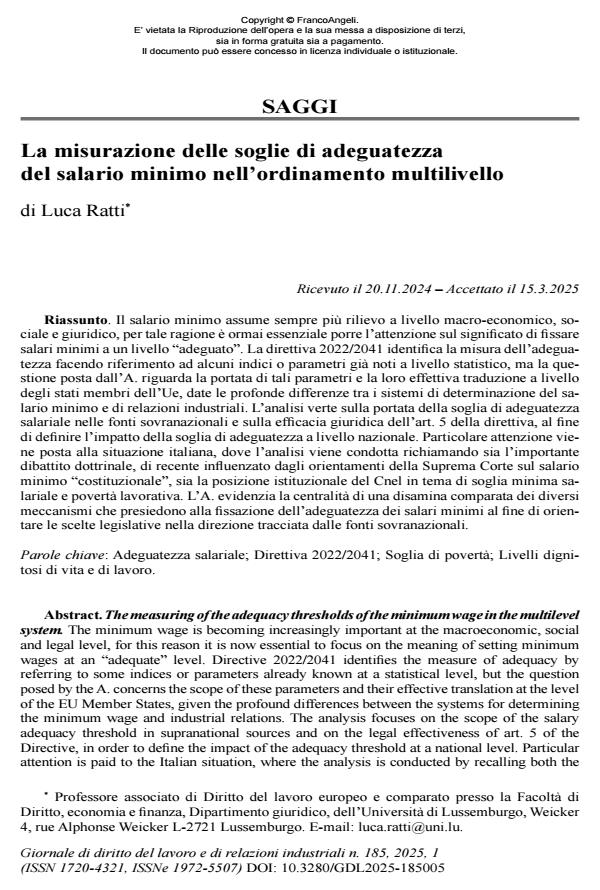La misurazione delle soglie di adeguatezza del salario minimo nell’ordinamento multilivello
Titolo Rivista GIORNALE DI DIRITTO DEL LAVORO E DI RELAZIONI INDUSTRIALI
Autori/Curatori Luca Ratti
Anno di pubblicazione 2025 Fascicolo 2025/185
Lingua Italiano Numero pagine 6 P. 57-62 Dimensione file 220 KB
DOI 10.3280/GDL2025-185005
Il DOI è il codice a barre della proprietà intellettuale: per saperne di più
clicca qui
Qui sotto puoi vedere in anteprima la prima pagina di questo articolo.
Se questo articolo ti interessa, lo puoi acquistare (e scaricare in formato pdf) seguendo le facili indicazioni per acquistare il download credit. Acquista Download Credits per scaricare questo Articolo in formato PDF

FrancoAngeli è membro della Publishers International Linking Association, Inc (PILA)associazione indipendente e non profit per facilitare (attraverso i servizi tecnologici implementati da CrossRef.org) l’accesso degli studiosi ai contenuti digitali nelle pubblicazioni professionali e scientifiche
Il salario minimo assume sempre più rilievo a livello macro-economico, sociale e giuridico, per tale ragione è ormai essenziale porre l’attenzione sul significato di fissare salari minimi a un livello “adeguato”. La direttiva 2022/2041 identifica la misura dell’adeguatezza facendo riferimento ad alcuni indici o parametri già noti a livello statistico, ma la questione posta dall’A. riguarda la portata di tali parametri e la loro effettiva traduzione a livello degli stati membri dell’Ue, date le profonde differenze tra i sistemi di determinazione del salario minimo e di relazioni industriali. L’analisi verte sulla portata della soglia di adeguatezza salariale nelle fonti sovranazionali e sulla efficacia giuridica dell’art. 5 della direttiva, al fine di definire l’impatto della soglia di adeguatezza a livello nazionale. Particolare attenzione viene posta alla situazione italiana, dove l’analisi viene condotta richiamando sia l’importante dibattito dottrinale, di recente influenzato dagli orientamenti della Suprema Corte sul salario minimo “costituzionale”, sia la posizione istituzionale del Cnel in tema di soglia minima salariale e povertà lavorativa. L’A. evidenzia la centralità di una disamina comparata dei diversi meccanismi che presiedono alla fissazione dell’adeguatezza dei salari minimi al fine di orientare le scelte legislative nella direzione tracciata dalle fonti sovranazionali.
Parole chiave:Adeguatezza salariale; Direttiva 2022/2041; Soglia di povertà; Livelli dignitosi di vita e di lavoro.
Luca Ratti, La misurazione delle soglie di adeguatezza del salario minimo nell’ordinamento multilivello in "GIORNALE DI DIRITTO DEL LAVORO E DI RELAZIONI INDUSTRIALI " 185/2025, pp 57-62, DOI: 10.3280/GDL2025-185005